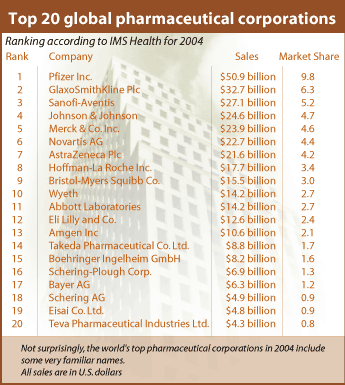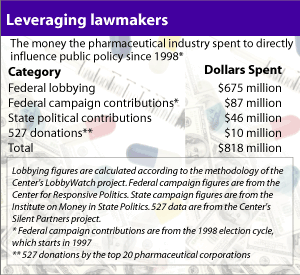Entered into the database on Monday, July 11th, 2005 @ 01:28:18 MST
The drug industry's huge investments in Washington—though meager compared
to the profits they make—have paid off handsomely, resulting in a series
of favorable laws on Capitol Hill and tens of billions of dollars in additional
profits. [See What the Industry Got.] They have also fended off measures aimed
at containing prices, like allowing importation of medicines from countries
that cap prescription drug prices, which would have dented their profit margins.
Pfizer, the world's largest drug company, made a profit of $11.3 billion last
year, out of sales of $51 billion. The industry's multi-faceted influence campaign has also led to a more industry-friendly
regulatory policy at the Food and Drug Administration, the agency that approves
its products for sale and most directly oversees drug makers. [See FDA: A Shell
of its Former Self] Most of the industry's political spending paid for federal lobbying. Medicine
makers hired about 3,000 lobbyists, more than a third of them former federal
officials, to advance their interests before the House, the Senate, the FDA,
the Department of Health and Human Services, and other executive branch offices.
In 2003 alone, the industry spent nearly $116 million lobbying the government.
That was the year that Congress passed, and President George W. Bush signed,
the Medicare Modernization Act of 2003, which created a taxpayer-funded prescription
drug benefit for senior citizens. That figure was not anomalous. In 2004, drug makers upped their reported expenditures
on lobbyists to $123 million, a record amount for the industry. Of the 1,291
lobbyists who were listed that year as prepresenting pharmaceutical corporations
and their trade groups, some 52 percent were former federal officials. By adding the benefit to Medicare, the government program that provides health
insurance to some 41 million people, the industry found a reliable purchaser
for its products. Thanks to a provision in the law for which the industry lobbied,
government programs like Medicare are barred from negotiating with companies
for lower prices. Critics charge that the prescription drug benefit will transfer wealth from
taxpayers, who provide the funding for Medicare, to pharmaceutical firms. According
to a study done in October 2003 by Boston University professors Alan Sager and
Deborah Socolar, 61 percent of Medicare money spent on prescription drugs will
become profit for drug companies. Drug-makers will receive $139 billion in increased
profits over eight years, the study predicts. The Medicare prescription drug
benefit starts in 2006. America the lucrative Many blame the industry's clout in Congress and with the executive branch for
the high price of drugs. While many governments worldwide have regulated drug
prices, the industry has been able to block a host of measures aimed at controlling
prices in the United States. In the past few years, the industry has mounted
an effective, organized campaign against legalizing importation of drugs from
Canada. As the Center reported in January, the industry trade group, Pharmaceutical
Research and Manufacturers of America, hired a former U.S. ambassador to Canada,
Gordon Giffin, and his top aide to lobby the Canadian government on the issue.
The industry's pressure may be paying off. Last week, Canadian Health Minister
Ujjal Dosanjh announced that his government would ban the bulk export of prescription
drugs and crack down on Internet pharmacies that sell drugs to Americans. A spokesman for PhRMA, Jeff Trewitt, told the Center in January that price
controls thwart innovation and importation of drugs pose serious health risks.
The top 20 drug corporations and the industry's two trade groups, PhRMA and
the Biotechnology Industry Organization, which represents biomedicine companies,
disclosed lobbying on more than 1,600 bills between 1998 and 2004. They may
have lobbied on far more bills; the Center could only count bills specifically
mentioned by the companies and trade groups in their filings. In many cases,
lobbyists list issues, like "animal health issues," rather than specific
bills. In counting the number of bills, the Center excluded those lobbied on
by BIO that relate solely to biotechnology issues, such as genetically engineered
foods. Apart from Congress, the industry lobbied an array of agencies including the
Department of Health and Human Services, the Food and Drug Administration and
the State Department on dozens of issues. For instance, PhRMA lobbied 33 federal
agencies on 39 issues separately identified under the Lobbying Disclosure Act
of 1995. As the Center reported last week, the agencies include the Office of the U.S.
Trade Representative, which shapes the country's trade agreements with other
nations. Since 1998, it has filed 59 lobbying reports concerning the USTR, more
than any other lobby or interest. In recent years, the industry has shown significant power in influencing U.S.
trade policy. For example, current drafts of the Dominican Republic-Central
American Free Trade Agreement reflect PhRMA's desire to remove price controls
on drugs and provide intellectual property protection in proposed member countries.
Recently, the USTR, at the behest of the pharmaceutical industry, pressured
Guatemala into repealing a recently passed law permitting wider marketing of
generic drugs. The top 20 corporations and the trade groups reported spending nearly $478
million on lobbying, or nearly 70 percent of all the money the industry reported.
These corporations had roughly 64 percent of the global market share, according
to IMS Health, a private consulting company that studies the industry. Congress is most frequently listed as a target of the industry's lobbying attentions;
contacts with the House or Senate are listed on about 5,500 lobby disclosure
reports. The Department of Health and Human Services, the Centers for Medicare
and Medicaid Services, the Food and Drug Administration and the Executive Office
of the President are other agencies heavily lobbied by the industry. Like other well connected interests in Washington, pharmaceutical firms look
to former insiders to carry their message to Congress and executive branch officials.
In May 2003, as the battle over the Medicare legislation was climaxing, the
Pharmaceutical Research and Manufactures of America, the industry trade group,
hired the newly formed lobby shop of Larson Dodd, LLC to join its already formidable
army of representatives swarming the hallways of Congress. The hiring of Dave
Larson and Quin Dodd by PhRMA—and later by Wyeth and other drug manufactures—was
in keeping with the industry's standard operating procedure: employing former
officials to lobby on bills sponsored by their ex-bosses. Larson was a health policy advisor to Senate Majority Leader Bill Frist, the
chief sponsor of a Medicare bill that, six months later, would become law, with
potentially tens of billions of dollars of windfall for the drug companies.
Dodd is a former legislative director to Sen. Kay Bailey Hutchison, the fourth
ranking Republican in the upper chamber. A third of all lobbyists employed by the industry are former federal government
employees, including more than 15 former Senators and more than 60 former members
of the U.S. House of Representatives. The two trade groups, PhRMA and BIO, are
headed by two influential former members of Congress. PhRMA chief Billy Tauzin
and BIO president Jim Greenwood were on committees that regulated drug companies
and they each sponsored several bills related to the industry. The Center reviewed the 1,600 plus bills the top 20 drug corporations and PhRMA
and BIO lobbied. Sponsors of more than 50 percent of those bills had one or
more former staff members representing the industry. A few of the sponsors have
gone on to become lobbyists themselves. Political giving Nearly $87 million of the contributions went to federal politicians in campaign
donations, with almost 69 percent going to Republican candidates. Top recipients
of the industry's campaign money include President George W. Bush (upwards of
$1.5 million) and members who sit on committees that have jurisdiction over
pharmaceutical issues. In the states, the industry gave more than $46 million to candidates since
'98, according to the Institute on Money in State Politics, which tracks campaign
finance at the state level. The Center could not determine the amount drug interests spent on lobbying
in states because of the lack of comparable state disclosure requirements for
expenditures. But their lobbying, campaign donations and grassroots efforts
have taken on an added dimension because many states are threatening the industry's
high profit margins in a way the federal government and Congress have been unwilling
to do. With states running into fiscal crises, several governors and legislatures
have been exploring ways to contain drug prices. Among the several options that
have been considered around the country include allowing seniors and others
to legally buy drugs from Canada and other countries. Though some states have been less amenable to drug industry pressure, the drug
industry hasn't given up the fight. For Washington's biggest spending lobby,
it's a small investment to make for its continuing prosperity. 
The U.S. government contributes more money to the development of new drugs—in
the form of tax breaks and subsidies—than any other government. Of the
20 largest pharmaceutical corporations, nine are based in the United States.
Yet drugs are more expensive in the United States than in any other part of
the world, and global drug companies make the bulk of their profits in the United
States.
Marketing Maladies
More than a third of pharmaceutical companies' resources go into promotion
and marketing.
Company
Marketing costs
Research and Development
$16.90 billion
$7.68 billion
$12.93 billion
$5.20 billion
$5.59 billion
$9.26 billion
$15.86 billion
$5.20 billion
$7.35 billion
$4.01 billion
$8.87 billion
$4.21 billion
$7.84 billion
$3.80 billion
$7.24 billion
$4.01 billion
$6.43 billion
$2.50 billion
$5.80 billion
$2.46 billion
$4.92 billion
$1.70 billion
Annually, the industry spends up
to $60 billion on drug marketing—nearly twice what it spends on research
and development. In 2004, Pfizer spent almost $120 million for media ads
for Lipitor, the world's number-one selling prescription drug, while companies
promoting erectile dysfunction treatments Viagra, Levitra and Cialis spent
$425 million. Direct to consumer advertisement has also grown significantly:
from $791 million in 1996 to $3.8 billion in 2004.
Lobbying numbers since 1998
Amount spent on lobbying
$675 million
Lobbyists
3,009
Former officials who registered to lobby
1,014
Former members of Congress who lobbied
75
Bills lobbied
More than 1,600

In addition to hiring former members and their staffs, the industry has also
helped keep lawmakers in office by making political contributions. Since the
1998 election cycle, employees of the pharmaceutical and health product industry,
their family members and industry political action committees have given $133
million in campaign contributions to candidates running for federal and state
offices, according to the Center for Responsive Politics. Since 2000, the top
drug corporations and their employees and PhRMA gave more than $10 million to
527 organizations, tax-exempt political committees which operate in the grey
area between federal and state campaign finance laws.
Victoria Kreha, Alexander Cohen, Kevin Boettcher and Emily McNeill contributed
to this report.